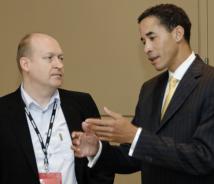Oracle stair-steps to on-demand

Oracle president Charles Phillips took some time out this afternoon to give me an overview of the company's software-as-a-service architecture, following up on the earlier discussion with fellow Enterprise Irregular bloggers. Oracle is concerned that glib assertions and misconceptions about multi-tenancy are causing people to undervalue its own expertise and assets in the on-demand space.

Other well-known SaaS vendors are even more equivocal in their actions (whatever their rhetoric). Read NetSuite's S-1 filing and you'll discover that, although smaller customers share multi-tenant instances, once an organization reaches 300-400 users, NetSuite will normally move it to a dedicated instance. Larger customers are allocated dedicated server clusters. On-demand talent management vendor Workstream, as I described recently, uses VMware virtualization technology to host dedicated instances. Tomorrow, by the way, I'll be discussing the trend towards virtualization as a 'shortcut to SaaS' in a webinar (see disclosure) with virtual appliance vendor rPath and its customer KnowledgeTree.
All of these SaaS pureplay examples provide validation to Oracle's own approach, even without taking into account the arguments Oracle advances regarding the needs of its own customer base. Oracle's on-demand customers on average have twice the user numbers of Salesforce.com, Phillips told me. Many of these larger organizations are forbidden by law from putting their data on the same servers as other organizations, he told me. Some are federal bodies who cannot allow anyone who is not a US citizen to go near their servers. "This security thing is much bigger than you're giving credit for. What customers care about is, I don't want my data co-mingled with somebody else's."
To meet such needs, Oracle has developed what it calls a 'pod' architecture for its on-demand data centers. These pods are self-contained sets of functionality — sometimes just an application server and database, sometimes a complete infrastructure with identity management, load balancing, firewalls and so on. Most often, though, the infrastructure services are shared across multiple application and database pods. Indeed, this shared-services approach is part of Oracle's argument against the need for multi-tenant databases. "Where that resides is an architectural choice," said Phillips. "I can build that in the dabatase or I can build that in the management layer above the database. A class of customers won't go for their data being in the same database ... so we decided to put the multi-tenancy option at the management layer."
The pods that serve smaller customers may be one-to-many, multi-tenant instances. Others are dedicated to one-to-one to a single customer. Some are many-to-one, for example a cluster of pods each serving the separate businesses of GE. There are different types of pods, too. Some are tailored to the needs of specific timezones, others have specific performance or function profiles, or they're tailored to specific classes of customer or business. Others are deployed to customer premises, but managed remotely by Oracle.
The notion of pods is not dissimilar to Workstream's approach, but the creation of tailored pods is an interesting twist and one that perhaps illustrates the scale of Oracle's hosted services. I can imagine that in the future Salesforce.com may copy elements of this model, particularly as its Force.com platform introduces more heterogenity into the Salesforce.com data center.
The one thing that Salesforce.com doesn't have to do, of course, is support a huge variety of on-premise implementations on whatever platforms and configurations customers choose to deploy. This uncontrollable overhead was highlighted by former Oracle On Demand chief Timothy Chou in his book The End of Software as a big drag on the economics of conventional software vendors. Oracle has to invest in product development and technical support for all the unpredictably weird and wonderful things that its customers choose to do with its products. But Phillips replied that things have moved on since Chou's book was published. In particular, he cited Oracle's Software Configuration Manager, which provides automated support to help customers follow best practice in their on-premise implementations and maintenance. Phillips says this has already been downloaded some 20,000 times despite relatively little promotion by Oracle.
In other words, the divide between on-premise and on-demand is no longer the black-and-white, good-vs-evil chasm that many try to claim. Oracle is encouraging its customers to adopt the same implementation and configuration best practices, leading to greater homogeneity among the installed base. At the same time, it's adapting its on-demand offerings to fit the diverse requirements of a heterogenous customer base.
In a revealing comment, Phillips linked all these initiatives together as a roadmap leading to an on-demand destination: "It's a stair-step to on-demand," he said. This year, a customer uses configuration manager, Perhaps next year they outsource the management of the on-premise instance to Oracle. Then the year after, perhaps they'll feel comfortable enough to let Oracle host it off-site in its own data center.
Phillips reminded me that Larry Ellison of course has been talking about the inevitability of the on-demand model since the launch of the original incarnation of Oracle On Demand back in 1998 (no reminder needed, since I covered the original story). No one at the company knows how long it will take until — or whether — customers will come round to the on-demand model. But it seems Oracle is, after all, committed to shifting them in that direction.